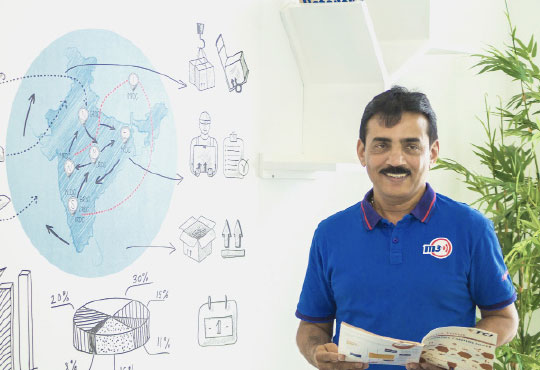Omni Channel Challenges
Anil Chinnabhandar, SVP - SCM, Landmark Group

The e-commerce wave has swept the consumers like never before in India. Thanks to the giants of e-commerce players, both foreign and domestic; e-commerce has taken the traditional Brick & Mortar retail into a completely different gamut! In the modern era, the Lady with the smart phone has become the most powerful buyer of goods and services. Without having to move out of her lounge chair, she is able to make every progressive retailer to ‘dance to her’ music literally! Traditional retailers who had taken the customer for ‘granted’ with service levels, quality and the price has now been given a harsh dose of their own medicine. The smart customer can easily make a retailer pay hefty penalties on untimely, low quality, dissatisfied goods and services by returning the same and seeking 100 percent refund on the purchase. However, smart retailers’ benefit from converting such informed customers instantly by offering value for money.
Omni channel is yet another opportunity for these smart retailers to offer their goods and services at the first attempt of sale itself. An apparel retailer may have brought out a new range of clothing, which is trendy and tempting. When the customer has seen the range either at a store or at a kiosk or at a digital site or even through a social network, and decides to buy the item, her exact style, color, size should be available at that moment. Typically the stores do not carry infinite levels of inventory, meaning quite often the required size may not be readily available at that store. In Omni channel world, customer will need to be exposed to the entire inventory holding across multiple stores, cities, warehouses, so that the first attempt of the purchase has total success. This is the primary challenge for the retailers.
If the inventory that is sold to the customer is not available physically at the store, or if the customer has made a purchase online or via kiosk, the product must be supplied to the customer either on a door delivery or pick up at the agreed location (store?) at no additional costs to the customer. Let’s say a customer has purchased a product via endless aisle in a store in Bengaluru, while the product is physically located at a store in New Delhi. The retailer must ‘reserve’ that product immediately after the sale and get that product moving down to Bengaluru immediately. This poses another big challenge with timely deliveries, quality delivery and cost optimal delivery mode.
While customer is not paying for any of the packing and shipping activities, those costs are additional to the retailer in the Omni channel environment. But the ‘cost of losing’ a customer perhaps outweighs the additional costs. Omni channel demands highest level of customer responsiveness at stores, online, warehouses, transport and at customer service teams. The backend teams who were hitherto unaware of the frontend customers and the need for quality packaging, shipping and follow-ups must be taught immediately to adapt to the new demands within this Omni channel world. Cost of a lapsed delivery (or non-delivery), badly packaged product or a wrong product may lead to an immediate return of the product as well as serious damage to the reputation of the retailer. Reverse logistics costs also can bleed the retailer more than ever before under Omni channel environment.
While the Omni channel perhaps offers the highest levels of customer experience and satisfaction, managing Omni environment for a traditional brick and mortar or a pure-play online retailer becomes a huge challenge. Retailers would need highly reliable and real-time system support at each step of the value chain; right from presentation of the range, assortment plans, demand sensing, inventory visibility, storage and distribution. Smart and quick to use dashboards enabling faster decision making for managers and accurate inventory visibility along with the reliable timelines for operations teams would be required. Sourcing & Planners would require intelligent insights into the trends, fashion and ‘saleable’ styles including geo-based demand sensing signals. Supply chain teams would need smart inventory management systems and highly efficient delivery systems for both forward and reverse logistics. Though there are various tools, applications, apps and Business intelligence tools are available in the market, retailers have to closely choose between what works for them best at the shortest time span rather than a ‘perfect’ traditional solution, which can consume months or years of implementation.
While Omni channel offers a great opportunity to acquire and impress the customer, the same opportunity may exert enormous pressure on the entire value chain demanding highest levels of efficiencies. But without Omni channel the modern retailers especially in the fashion retail may struggle to improve profitability. A smart retailer can ensure to ‘touch’ their target audience using digital media effectively across malls, homes, work and even at the social networks and most importantly ‘convert’ that touch into a real sale and deliver a superior customer experience with the help of suite of intelligent IT systems!
























































.jpg)
.jpg)








.jpg)

.jpg)

.jpg)
.jpg)



.jpg)


.jpg)





























.jpg)

.jpg)
.jpg)

.jpg)
.jpg)

































.jpg)

.jpg)



















.jpg)
















.jpg)












































































































